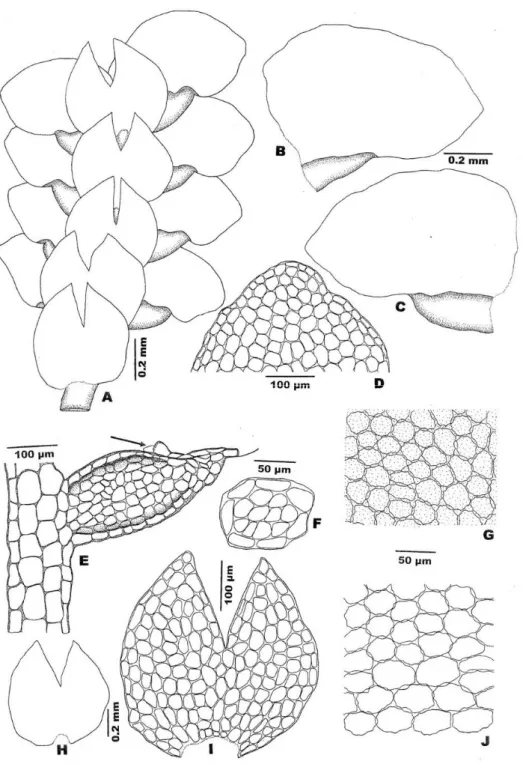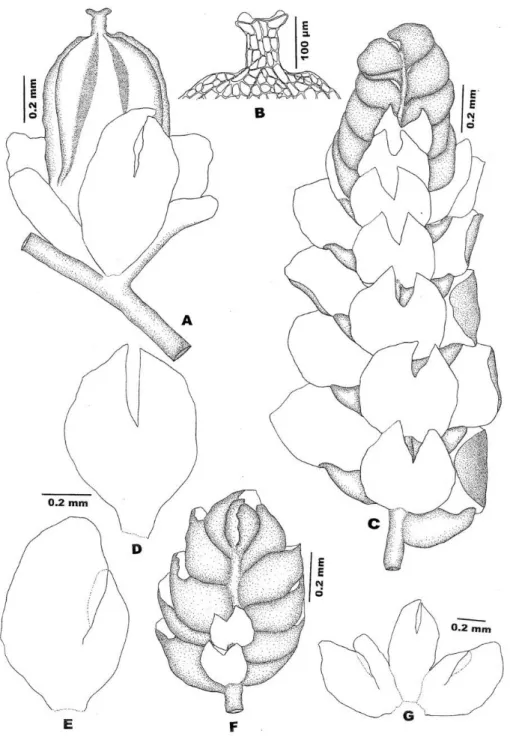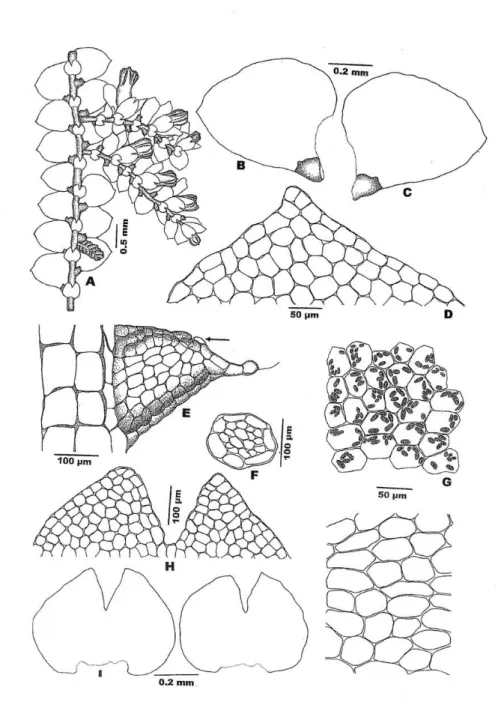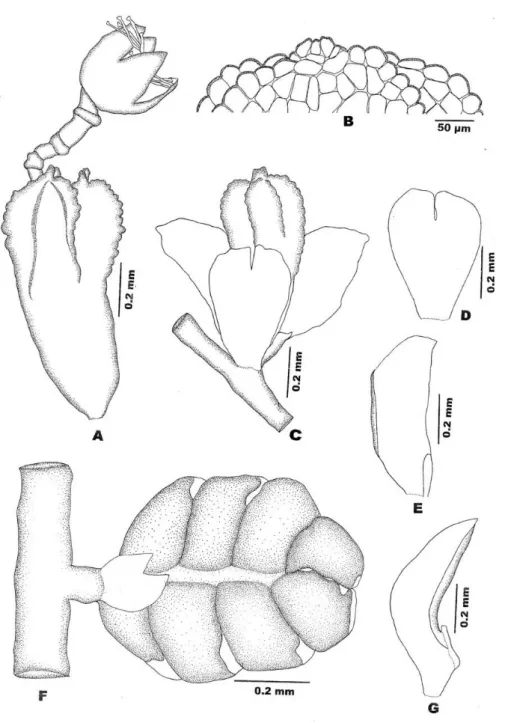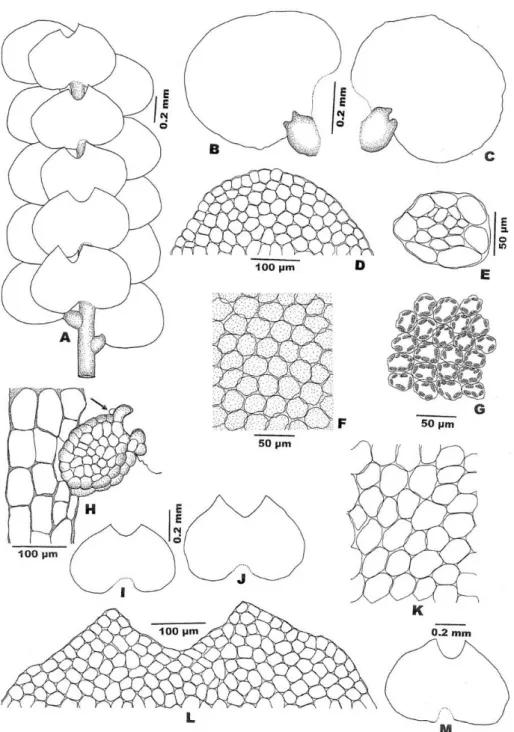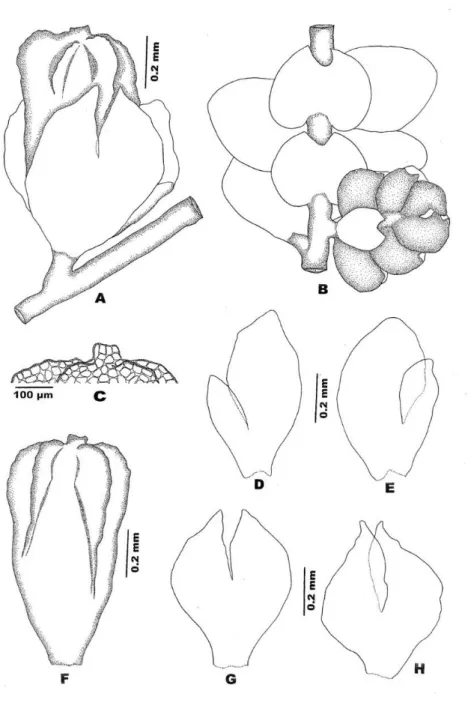A TAXONOMIC TREATMENT OF LEJEUNEA DISCRETA, L.
EIFRIGII AND L. SORDIDA, NEW TO PENINSULAR MALAYSIA
1Lee G. E., 1A. Damanhuri, 1A. Latiff & 2S. Robbert Gradstein
1 School of Environment and Natural Resource Sciences, Faculty of Science and Technology, Universiti Kebangsaan Malaysia, 43600, Selangor, Malaysia 2 Department of Systematic Botany, Institute of Plant Sciences, University of
Göttingen, Untere
Karspüle 2, 37073 Göttingen, Germany
Abstract: Lejeunea discreta Lindenb., Lejeunea eifrigii Mizut. and Lejeunea sordida (Nees) Nees, reported for the first time from Peninsular Malaysia, are fully described and illustrated.
Keywords: Lejeunea discreta, Lejeunea eifrigii, Lejeunea sordida, Lejeuneaceae, taxonomy, Peninsular Malaysia
Introduction
Lejeunea is a large, pantropical genus, with over 100 species. It is also the largest genus in the Lejeuneaceae which is the most specious family of liverworts with about 1000 species in 90 genera (Gradstein et al. 2003). Most of the species of Lejeunea in Malaysia are yet to be studied, hence the genus is still very poorly known and the circumscription of the genus is still unsettled.
Twenty seven species of Lejeunea have been reported from Malaysia, mainly from Mount Kinabalu, Sabah (Mizutani 1966, 1969, 1970, Tixier 1971, 1980).
In this paper, we report three species of Lejeunea, i.e. Lejeunea discreta Lindenb., L. eifrigii Mizut. and L. sordida (Nees) Nees, which are newly discovered in Peninsular Malaysia. All the descriptions and illustrations are based on fresh materials. The species were discovered in the framework of a study on the 2 genus Lejeunea in Malaysia, which is in progress. We expect that further new discoveries will be made in the future.
1. Lejeunea discreta Lindenb., in Gottsche, Lindenb. & Nees, Syn.
Hepat.: 361 (1845). Figures 1 & 2.
Hygrolejeunea discreta (Lindenb.) Schiffn., Consp. Hepat. Archip. Indici:
266 (1898) Taxilejeunea discreta (Lindenb.) R.M. Schust., Beih. Nova Hedwigia 9: 138 (1963). TYPE: Indonesia. Java. “inter L. thymifolium ß discretam”, collector unknown (not seen).
= Lejeunea vaginata Steph., Sp. Hepat. 5: 791 (1915). TYPE: Japan. Kochi Pref., 1904, S. Okamura 186 (holotype: G!).
For further synonyms see Mizutani (1961, 1970) and Grolle (1981).
Dioicous. Plants relatively large, 1.1–1.2 mm wide, usually yellowish green when fresh to dark brown when dried, irregular and densely pinnate to bipinnate with branches widely to obliquely spreading. Stems 0.1–0.2 mm in diameter, ventral merophyte on the stem 2 cells wide, cross-section of stem about 5 cells high, consisting of 7 epidermis cells with thick walls surrounding 10 medullary cells, epidermis cells distinctly larger than medullary cells, epidermis cells 33– 40 μm wide, medullary cells 16–30 μm wide. Leaves closely imbricate to contiguous, widely spreading when moist, sometimes somewhat convex when dried. Leaf lobes 0.7–0.8 mm long and 0.5–0.6 mm wide (when flattened), ovate, leaf apex obtuse, occasionally recurved, leaf margin entire, the ventral margin arched, when flattened forming an angle of 1000–1200 with the keel, the line of insertion rather short, J-shaped, along 10 lobe cells. Leaf cells rather uniform, gradually become smaller towards the leaf margin, usually pentagonal, 3 irregular quadrate to rectangular towards the leaf margin, apical cell 13–33 μm long and 6.7–13 μm wide, median cell 40–53 μm long and 33–53 μm wide, basal cell 53–86 μm long and 33–66 μm wide, cell walls hyaline, with large trigones and occasionally intermediate thickenings, 1–2 per cell, 0–1 between 2 adjacent trigones. Oil bodies not observed. Cuticle rough, each cell covered by numerous minute papillae. Leaf lobules large, sometimes reduced, 0.2–0.4 mm long and 0.10–0.16 mm wide, up to 1/2 as long as the lobe, ovate-rectangular, inflated along the keel, apex truncate, constricted, keel curved, smooth, free margin strongly incurved, sometimes flat, the hyaline papilla on the proximal side of the apical tooth, margin between tooth and sinus 4 cells long, with a distinct rectangular cell, 50 μm long and 33 μm wide, below the apical tooth.
Underleaves 0.4–0.5 mm long, 0.40–0.43 mm wide, 3–4 times as wide as the stem, contiguous to imbricate, suborbicular (slightly longer than broad), covering half of the lobules, bilobed to 1/2 of underleaf length, tips obtuse to acute and sometimes ending with solitary cell, lobes straight, sometimes slightly connivent, sinus narrow and deep, acute, V-shaped, margin entire, base shallowly curved. Androecia 0.7–0.9 mm long, 0.5–0.6 mm wide with bracts, terminal on short or long branches, with bracts closely imbricate. Male bracts in
5–6 pairs, lobule strongly inflated, almost same size as the lobe. Male bracteoles 0–2, smaller than the underleaf, present only at the base of the androecia.
Antheridia not seen. Gynoecia terminal on short or long branches, sometimes on the main stem, bracts loosely arranged, sometimes somewhat crowded, with one innovation, 1–2 gynoecia in a lateral row due to repeatedly fertile innovations, leaf sequence of innovation lejeuneoid. Bracts larger than the leaves, erect spreading when moist, not enveloping the perianth, bracts and bracteoles in 2 series. Lobes 0.7–4 0.8 mm long, 0.5–0.6 mm wide, ovate, apex obtuse to acute.
Lobules 0.5–0.6 mm long, 0.1–0.2 mm wide,1/2 the width of the lobe, 2/3 the length of the lobe, linear, apex obtuse to truncate, attached to the lobe by a short and straight keel, 0.3–0.4 mm long. Bracteole 0.6–0.7 mm long, 0.4–0.6 mm wide, 1/2 as long as the perianth, larger than the underleaf, ovate with the tips acute, lobes connivent, sinus narrow, acute, almost equally bifid, 1/2 bilobed.
Perianth 1.0–1.2 mm long, 0.5–0.6 mm wide, emergent up to 1/2 of its leaf length, elliptical, with 5 keels and a 3–4 cells long beak, the beak large, trumpet- shaped, cells of the lower part of the perianth flat, base of the perianth straight and without any stalk-like elongation.
Lejeunea discreta is recognized by the obtuse leaf apex, large leaf lobules (to 1/2 as long as the lobe), large, rectangular disc cell below the apical tooth, incurved free margin of leaf lobule, rough cuticle, and leaf cells with large trigones and nodulose intermediate thickenings. Besides this, the perianth with a large trumpet-shaped beak is peculiar to this species.
Specimens examined. PENINSULAR MALAYSIA. Pahang: Genting Highlands, Genting theme park, open area, 1500 m alt., 2008, G.E. Lee 1146 (UKMB); Genting theme park (outdoor), 1500 m alt., 2008, G.E. Lee 1037 (UKMB); summit area of Gunung Ulu Kali, 1600 m alt., 1996, N. Ohnishi 2514 (HIRO); Fraser Hill, along the street, open area, 1275 m alt., 2008, G.E. Lee 1181, 1423, 1427 (UKMB). Perak: Gunung Korbu, summit area of Gunung Korbu, 2183 m alt., 2009, Damanhuri s.n. (UKMB). BORNEO. Malaysia, Sabah: Mount Kinabalu, between Tenompok Pass and Kambaranga Radio Station, 1400-1900 m alt., 1963, M. Mizutani 2110e (NICH); between Kambaranga Radio Station and Waterfalls, 2000–2146 m alt., 1963, M. 5
Mizutani 2396 (NICH); around Kambaranga Radio Station, south slope of Mount Kinabalu, 2140 m alt., 1963, M. Mizutani 2601 (NICH); mossy forest between Tenompok Pass and Ulu Damaian, S slope of Mount Kinabalu, 1463- 1500 m alt., 1963, M. Mizutani 3239 (NICH); Kinabalu area, in a virgin forest near Forest Department Bungalow, Sosopodon, Kundasang, 1350 m alt., 1963, M. Mizutani 6123, 6142 (NICH). JAVA. Preanger: Mt. Patuha SW of Bandung, Montane forest along road to crater, 2000–2100 m alt., 2009, Afiatri Putrika 2 (GOET).
Distribution: Australia, Bhutan, Borneo (Sabah), Cambodia, China, India, Indonesia (Java, Maluku, Sulawesi, Sumatra), Japan, Korea, Nepal, New Caledonia, Papua New Guinea, Peninsular Malaysia, Philippines and Sri Lanka.
Ecology: The five specimens collected in Peninsular Malaysia were found growing on tree trunks and branches, on tree fern (Cyathea sp.) trunks, and on shrubs, at 1200–2000 m alt. Mizutani (1970) reported this species from Mount Kinabalu, Sabah, on tree trunks, shrubs, branches of fallen trees and lianas at almost the same altitudinal range, 1500–2000 m. Zhu and So (2001) reported this species from China on tree trunks, branches, decaying logs, sometimes on ferns and the leaves of shrubs at 1050–2200 m alt. In Himalayan National Park, India, the species has been reported growing on soil at 1950 m alt. (Singh &
Singh 2008). In general, Lejeunea discreta seems to have a preference for tree trunks at high elevations, above 1000 m alt. 6
2. Lejeunea eifrigii Mizut., J. Hattori Bot. Lab. 33: 244 (1970). Figures 3
& 4.
Taxilejeunea acutiloba Eifrig, Ann. Bryol. 9: 94 (1936) (non Lejeunea acutiloba (Tayl.) Tayl. 1845). = Taxilejeunea acutiloba forma major Eifrig, Ann. Bryol. 9: 96 (1936). LECTOTYPE (fide R. Grolle, in sched.): Indonesia.
Java, Salak, Schiffner 3223 (JE!). Since the type material of Taxilejeunea acutiloba Eifrig (Indonesia, Schiffner 2962a), kept in the herbarium of the university of Jena (JE), only contains Taxilejeunea apiculata (Sande Lac.) Eifrig, Dr. Grolle has proposed (in sched.) to select the type of Taxilejeunea acutiloba forma major Eifrig (Java, Schiffner 3223) as the lectotype of T.
acutiloba. Since the latter material fits the original description and illustration of T. acutiloba, the choice of Dr. Grolle is followed here.
Autoicous. Plants relatively large, 1.7–2.0 mm wide, usually yellowish green to pale green in the field to dark green when dried, irregularly and densely branched with branches widely spreading, sometimes with loosely pinnate branched. Stems 0.13–0.17 mm in diameter, ventral merophyte on the stem 2 cells wide, cross-section of the stem about 6 cells high, consisting of 7 epidermis cells with thin walls surrounding 16 medullary cells, epidermis cells distinctly larger than the medullary cells, epidermis cells 30–60 μm wide, medullary cells 20–40 μm wide. Leaves approximate, sometimes somewhat contiguous, erect spreading when moist, slightly convex, not crossing the stem, occasionally crispate when dried. Leaf lobes 0.4–0.8 mm long and 0.6–0.7 mm wide (when flattened), ovate, leaf apex apiculate, sometimes slightly obtuse, leaf margin entire, the ventral margin almost straight with the keel, weakly arched, when flattened forming an angle of 1200–1700 with the keel, the line of insertion rather short, J-shaped, 7
10 lobe cells. Leaf cells rather uniform, gradually become smaller towards the leaf margin, usually quadrate to hexagon, rectangular towards the leaf margin, apical cells 20–30 μm long and 12–17 μm wide, median cells 50–58 μm long and 20–30 μm wide, basal cells 62–80 μm long and 20–33 μm wide, cell walls hyaline, with small trigones, intermediate thickenings not differentiated.
Oil bodies 3–8 per cell, finely segmented, round to oblong. Cuticle smooth. Leaf lobules rather small, sometimes reduced, 0.13–0.16 mm long and 0.09–1.10 mm wide, up to 1/4 as long as the lobe, ovate-oblong, inflated along the keel, apex obliquely truncate, sometimes constricted, keel curved, sinuate, free margin flat, the hyaline papilla on the proximal side of the apical tooth, margin between tooth and sinus 3 cells long, with a rather large, rectangular cell, 40 μm long, 20 μm wide, below the apical tooth. Underleaves 0.1–0.3 mm long, 0.6–0.7 mm wide, 2 times as wide as the stem, very distant, reniform (not longer than broad), covering half of the lobules, bilobed to 1/2 underleaf length, tips acute to obtuse, lobes almost straight, sinus narrow, acute to obtuse, U-shaped to narrow V- shaped, margin entire, base straight. Androecia 0.3–0.8 mm long, 0.3–0.5 mm wide with bracts, terminal on short or long lateral branches, along the stem, with bracts closely imbricate. Male bracts in 3–6 pairs, lobule strongly inflated, almost same size as the lobe. Male bracteole 0–1, smaller than the underleaf, present only at the base of the androecia. Antheridia not seen. Gynoecia terminal on short or long branches, bracts loosely arranged and sometimes somewhat crowded, with one innovation, 1–3 gynoecia in a lateral row due to repeatedly fertile innovations, leaf sequence of innovation lejeuneoid. Bracts smaller or sometimes almost same size as the leaf, erect-spreading when moist, not enveloping the perianth, bracts and bracteoles in 2 series. Lobes 0.6–0.8 mm long, 8 0.24–0.26 mm wide, linear to lanceolate, apex acute. Lobules 0.20–0.23 mm long, 13–15 μm wide, very small, sometimes reduced, 1/6 the width of the lobe, 1/3 the length of the lobe, linear, apex round to obtuse, attached to the lobe by a short and straight keel, 1.5–1.6 mm long. Bracteoles 0.5–0.6 mm long, 0.40–0.43 mm wide, 1/2 as long as the perianth length, larger than the underleaf, obovate with tips rounded, lobes approximate, sinus narrow, acute, almost equally bifid, 1/4 bilobed, margin entire. Perianth 1.0 mm long, 0.5 mm wide, emergent up to 1/3 of its leaf length, clavate, with 5 keels and a 2 cells long beak, cells of the perianth at the keels strongly mammillose, the base straight and without any stalk-like elongation.
The most remarkable feature of Lejeunea eifrigii is the long clavate perianth with 5 mammillose keels. The species can also be distinguished by the apiculate apex of the leaf lobe, the small, reniform underleaves, small trigones and lack of intermediate thickenings.
Specimens examined. PENINSULAR MALAYSIA. Pahang: Cameron Highlands, Mentigi trail, 1360 m alt., 2009, G.E. Lee 1168, 1170, 1185 (UKMB); Parit falls, 1340 m alt., 2009, G.E. Lee 1367 (UKMB); Genting
Highlands, along the road to Gunung Ulu Kali, 1650 m alt., 2009, G.E. Lee 1192, 1194 (UKMB). BORNEO. Malaysia, Sabah: Mount Kinabalu, between Kambaranga Radio Station and Waterfalls, 2000-2146 m alt., 1963, M. Mizutani 2482 (NICH); mossy forest between Tenompok Pass and Ulu Damaian, S slope of Mount Kinabalu, 1463-1500 m alt., 1963, M. Mizutani 3244 (NICH).
Distribution: Borneo (Sabah), China, Indonesia (Java, Sumatra), Japan, New Caledonia, Papua New Guinea, Peninsular Malaysia and Philippines. 9
Ecology: Among the six collections from Peninsular Malaysia, two specimens are collected on branches of tree at 1650 m alt. while the remaining specimens were from living leaves, fungi and rotten log at 1340–1365 m alt.
Mizutani (1970, 1977) reported this species from Mount Kinabalu, Sabah, on rock and tree trunks at 1350–2150 m alt. and from Luzon, Philippines, on boulders, tree trunk, root and rock at 800–2300 m alt. Specimens from China are mostly epiphyllous (Zhu & So 2001). In general, Lejeunea eifrigii occurs mostly at higher elevations, about 800-2300 m alt., on various substrates. 10
3. Lejeunea sordida (Nees) Nees, Nat. Eur. Leberm. 3: 278 (1838). Figures 5 & 6.
Jungermannia sordida Nees, Enum. Pl. Crypt. Jav.: 41 (1830).
Hygrolejeunea sordida (Nees) Steph., Sp. Hepat. 5: 570 (1914). Taxilejeunea sordida (Nees) Eifrig, Ann. Bryol. 9: 101 (1937) “1936”. TYPE: Indonesia.
Java. “in tumulis Baduorumsanctis”,Blume s.n. (holotype: STR!).
For further synonyms see Mizutani (1970).
Dioicous. Plants relatively large, 1.0–1.3 mm wide, usually glossy green to pale green in the field, dark brown when dried, irregularly and loosely pinnate with branches erect spreading. Stems 0.10–0.13 mm in diameter, ventral merophyte on the stem 2 cells wide, cross-section of stem about 6 cells high, consisting of 7 epidermis cells with thin walls surrounding 11 medullary cells, epidermis cells distinctly larger than medullary cells, epidermis cells 23–46 μm wide, medullary cells 13–20 μm wide. Leaves closely imbricate, obliquely spreading when moist. Leaf lobes 0.6–0.7 mm long and 0.5–0.6 mm wide (when flattened), orbicular, leaf apex broadly rounded, always flat, leaf margin entire, slightly sinuate, the ventral margin strongly arched, when flattened forming an angle of 600–900 with the keel, the line of insertion long, J-shaped, along 13 lobe cells. Leaf cells rather uniform, gradually become smaller towards the leaf margin, usually quadrate to pentagon, sometimes somewhat round, irregularly quadrate to rectangular towards the leaf margin, apical cell 20–27 μm long and 13–27 μm wide, median cell 33–40 μm long and 26–33 μm wide, basal cell 53–
80 μm long and 26–53 μm wide, cell walls hyaline, with large trigones and occasionally intermediate thickenings, 1–2 per cell, 0–1 between 2 adjacent trigones. Oil bodies 4–8 per cell, finely segmented, oblong, 11 sometimes ovate.
Cuticle rough, each cell covered by numerous minute papillae. Leaf lobules rather small, 0.1–0.2 mm long and 0.13–0.16 mm wide, up to 1/3 as long as the lobe, ovate, inflated along the keel, apex constricted, curved, U-shaped, keel curved, somewhat sinuate, free margin involute, the hyaline papilla on the proximal side of the apical tooth, margin between tooth and sinus 2 cells long, with not so indistinct, rectangular cell, 33 μm long and 20 μm wide, below the apical tooth. Underleaves 0.4–0.5 mm long, 0.6–0.7 mm wide, 7 times as wide as the stem, approximate to contiguous, reniform (wider than broad), always covering the lobules, bilobed to 1/4 underleaf length, tips acute to obtuse, lobes oblique, sometimes somewhat oblique, sinus broad, round to obtuse, U-shaped to V-shaped, margin entire, somewhat sinuate, base cordate without auricle.
Androecia 0.5–0.7 mm long, 0.3–0.4 mm wide with bracts, terminal on short or long branches, with bracts closely imbricate. Male bracts in 3–5 pairs, lobule strongly inflated, almost same size as the lobe. Male bracteole 0–1, smaller than the underleaf, present only at the base of the androecia. Antheridia not seen.
Gynoecia terminal on short branch, bracts loosely arranged, with one innovation, usually with 1–2 gynoecia in a lateral row, leaf sequence of innovation lejeuneoid. Bracts slightly larger than the leaf, erect spreading when moist, not enveloping the perianth, bracts and bracteoles in 2 series. Lobes 0.6– 0.7 mm long, 0.3–0.4 mm wide, ovate, apex obtuse, margin entire. Lobules 0.4– 0.5 mm long, 0.1–0.2 mm wide, 1/3 the width of the lobe, 2/3 the length of the lobe, lanceolate, apex obtuse, attached to the lobe by a short and straight keel, 0.2–0.4 mm long. Bracteoles 0.6–0.7 mm long, 0.4–0.5 mm wide, 1/2 as long as the perianth length, larger than the underleaf, ovate with the tips acute, lobes distant to overlapping, sinus acute, almost equally bifid, 1/2 bilobed, margin entire. 12
Perianth 1.0 mm long, 0.5 mm wide, emergent up to 1/3 of its leaf length, obovate, with 5 keels and a 2–3 cells long beak, cells of the perianth at the keels bulging, the base straight and without any stalk-like elongation.
Lejeunea sordida is the most common species of the genus Lejeunea in Peninsular Malaysia and is easily recognized by the large, reniform underleaves which always cover the lobule, the small leaf lobule, and distinct trigones and intermediate thickenings.
Specimens examined. PENINSULAR MALAYSIA. Johor: Kluang, Gunung Belumut, expedition base camp, 80 m alt., 2009, G.E. Lee 1231, 1232 (UKMB); Expedition trail no. 4, 80 m alt. 2009, G.E. Lee 1233 (UKMB);
Tangkak, Gunung Ledang, along the trail to the summit of Gunung Ledang, 200 m alt., 2009, G.E. Lee 1203, 1204 (UKMB). Kedah: Kulim, Sungai Sedim, expedition base camp, 50 m alt. 2009, G.E. Lee 1416 (UKMB). Pahang: Fraser Hill, main entrance in open area, 820 m alt., 2008, G.E. Lee 1154 (UKMB);
Genting Highlands, along the road to the Noah Mosque, open area, 1650 m alt., 2009, G.E. Lee 1195 (UKMB). Penang: Bukit Panchor, along the river trail,
2008, G.E. Lee 1054 (UKMB); Penang Hill, „broken staircase‟ trail in the mossy area, 750 m alt., 2008, G.E. Lee 1088, 1095, 1182 (UKMB). Selangor: Ulu Langat, Sungai Congkak, along the trail to Sungai Congkak waterfall, 30 m alt., 2009, G.E. Lee & H.Y. Tang 1179 (UKMB). BORNEO. Malaysia, Sabah:
Radau, N of Jesselton, coastal region of West Coast, 1963, M. Mizutani 6078 (NICH); Limestone area around Madai Cave, SW of Lahad Datu, East Coast, 60–100 m alt., 1963, Z. Iwatzuki 5722 (NICH). Sarawak: Kuching, Sungai Lalang, along the road to Bau, open area, 30 m alt., 2009, G.E. Lee 1159 (UKMB). 13
Distribution: Australia, Borneo (Sabah, Sarawak), Caroline Is., China, Fiji, Indonesia (Java, Sumatra), Japan, Micronesia, New Caledonia, Papua New Guinea, Peninsular Malaysia, Philippines, Samoa, Solomon Is. and Thailand.
Ecology: The 14 specimens collected in Peninsular Malaysia were found growing on tree trunks, leaves and branches, at about 30–1650 m alt. Mizutani (1970) reported this species from Radau and Madai Cave, Sabah, 10–100 m alt., mostly on tree trunks; two specimens were on rock. Mizutani (1977) recorded this species from Luzon, Philippines on lianas, branches, tree trunks and stumps at 500–2000 m alt. Zhu and So (2001) recorded this species from China, on tree trunks and, very rarely, on living leaves. In general, Lejeunea sordida grows mostly on tree trunks at a wide elevational range, from sea level to 2000 m. 14
Figure 1. Lejeunea discreta Lindenb.: A: Part of plant; B-C: Leaves; D: Apical cells of leaf lobe; E: Leaf lobule; F: Cross section of stem; G: Median cells of leaf lobe; H:
Underleaf; I: Cells of underleaf; J: Basal cells of leaf lobe; : hyaline papilla. All figures were drawn from G.E. Lee 1146.
Figure 2. Lejeunea discreta Lindenb.: a: Perianth; b: Apical cells of perianth; c: Part of plant with androecium; d: Female bracteole; e: Female bract; f: Androecium; g: Female
bracts and bracteole. a,b were drawn from G.E. Lee 1037, c-g from G.E. Lee 1146.
Figure 3. Lejeunea eifrigii Mizut.: A: Part of plant; B,C: Leaves; D: Apical cells of leaf lobe; E: Leaf lobule; F: Cross section of stem; G: Median cells of leaf lobe with oil bodies; H: Apical cells of underleaf; I,J: Underleaf; K: Basal cells of leaf lobe; : hyaline
papilla. All figures were drawn from G.E. Lee 1185.
Figure 4. Lejeunea eifrigii Mizut.: a,c: Perianth; b: Apical cells of perianth; d: Female bracteole; e,g: Female bracts; f: Androecium. All figures were drawn from G.E. Lee
1185.
Figure 5. Lejeunea sordida (Nees) Nees: A: Part of plant; B, C: Leaves; D: Apical cells of leaf lobe; E: Cross section of stem; F: Median cells of leaf lobe; G: Median cells of leaf lobe with oil bodies; H: Leaf lobule; I,J,M: Underleaves; K: Basal cells of leaf lobe;
L: Apical cells of underleaf; : hyaline papilla. G was drawn from G.E. Lee 1159, A,J,M were drawn from M. Mizutani 5722, the rest of the figures were drawn from G.E. Lee
1154.
Figure 6. Lejeunea sordida (Nees) Nees: a,f: Perianth; b: Part of plant with androecium;
c: Apical cells of perianth; d,e: Female bracts; g,h: Female bracteoles. All figures were drawn from G.E. Lee 1154.
Acknowledgments
This study is supported by National Science Foundation (NSF), Malaysia.
The first author is indebted to Dana Operasi UKM-OUP-PLW-11-46/2008 for supporting her financially to University of Göttingen, Germany under the supervision of Prof. Dr. S.R. Gradstein for 3 months. Many thanks go to all the curators of the herbaria of Geneva (G), Jena (JE) and Strasbourg (STR) for their hospitality during the visit and help in studying the type specimens of Lejeunea and to the Forestry Department of Peninsular Malaysia for organizing the expeditions during which most of the specimens were collected.
References
Gradstein, S. R., M. E. Reiner-Drehwald & H. Schneider. 2003. A phylogenetic analysis of the genera of Lejeuneaceae (Hepaticae). Bot. J. Linn. Soc. 143:
319–410.
Mizutani, M. 1961. A revision of Japanese Lejeuneaceae. J. Hattori Bot. Lab.
24: 115–302.
Mizutani, M. 1966. Epiphyllous species of Lejeuneaceae from Sabah (North Borneo). J. Hattori Bot. Lab. 29: 153–170.
Mizutani, M. 1970. Lejeuneaceae, subfamilies Lejeuneoideae and Cololejeuneoideae from Sabah (North Borneo). J. Hattori Bot. Lab. 33:
225–265.
Mizutani, M. 1975. Epiphyllous species of Lejeuneaceae from the Philippines. J.
Hattori Bot. Lab. 39: 255–262.
Mizutani, M. 1977. Lejeuneaceae from Philippines. J. Hattori Bot. Lab. 43:
127–136. 15
Singh, D. K. & S. K. Singh. 2008. Diversity in liverworts and hornworts of Great Himalayan National Park, Western Himalaya, India. In: H.
Mohamed, B. B. Bakar, A. N. Boyce, P. K. Y. Lee (eds.). Bryology in the New Millennium. Pp. 57–81. Kuala Lumpur: University of Malaya.
Tixier, P. 1971. A contribution to the bryological knowledge of Fraser‟s Hill station (Malaysia). Gard. Bull. Singapore 25: 335–353.
Tixier, P. 1980. Contribution to the bryological knowledge of Malaysia. III.
Cameron Highlands-mosses and epiphyllous liverworts. Nova Hedwigia 32: 377–392.
Zhu, R. L. & M. L. So. 2001. Epiphyllous liverworts of China. Nova Hedwigia Beiheft 121: 126–162. 16
